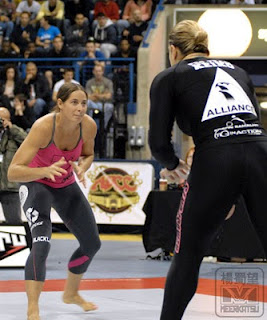BJJ is a male-dominated sport. At almost any academy you go to, you’ll find that the vast majority of practitioners are men. In tournaments, there are usually fewer women’s brackets than men’s, and within each bracket there are usually fewer female competitors. At the academy where I train, we don’t currently have any adult female practitioners – only recently have there been a few female kids that have begun to train.

In last year's ADCC (perhaps the most prestigious tournament in the world), there were only 16 female competitors split across two weight divisions. By comparison, there were 5 men's divisions with 16 competitors in each.
I’ve often wondered why so few women decide to take up BJJ. Over the next few posts I’ll discuss some of the reasons why this might be the case, as well as some tips (from my perspective) for aspiring female practitioners.
Although there are probably many reasons for the highly skewed sex ratio in our sport, I think the picture becomes clearer when we examine Brazilian Jiu Jitsu within a historical context. I’ll try to keep the history lesson brief, since we’re probably all familiar with the story of the Gracie legacy. If you are not, you can check out a very well-done biographical documentary of Helio Gracie for free on Youtube.
BJJ is a fairly young martial art, and the techniques developed by the Gracie family were secretively safeguarded for many years after its inception in the early 1900’s. Only in recent decades, following the notoriety it garnered by the early UFC events, has BJJ begun to enter the mainstream martial arts spotlight.
Helio Gracie is considered among the most important figures in Brazilian Jiu Jitsu history, both for developing the martial art and for his competitive achievements that promoted it. However, while his contributions to the martial arts cannot be overstated, the sexist attitudes of the early pioneers of BJJ are often glossed over in historical accounts. Indeed, Helio did not envision women participating competitively in Brazilian Jiu Jitsu.

Only men are included in nearly all historical images of the "Gracie Clan."
In the documentary I referenced earlier, Helio explains that “a man’s life is directed towards fighting. A woman’s is to procreate” (15:29). He goes on to explain that “women were made exclusively to be a wife, mother, and take care of the children. . . Every woman who doesn’t do exactly this is not right” (16:02).
In another interview, Kyra Gracie (one of the most decorated female grapplers in the world, and the most famous female grappler in the Gracie family) explains that she was told to “leave this [to the men]” and was patronized by the male BJJ practitioners in her family when she expressed interest in competing in BJJ at a high level (3:10 of the interview).

Kyra Gracie executing a picture-perfect armbar.
Viewed within this context, it isn’t surprising that female BJJ practitioners are rare – until relatively recently, they were discouraged from actively participating. This attitude is a relic of an unfortunate past. Without a tradition of female practitioners in the sport, it is completely understandable that women remain underrepresented. Luckily, this overtly sexist position towards female participation in BJJ no longer exists in most academies. I’ve yet to hear of any current academies that openly discourage women from training (at least as part of their policy).
The hope, of course, is that any remaining barriers preventing women from taking up the sport will continue to erode. However, there may be additional, more subtle pressures that discourage female participation. Over the next several posts, I’ll discuss some of these pressures and share of my experiences of training with women.


Great post! This topic is discussed a fair bit, but the points you raised are rarely made.
I’ve been meaning to write about that Kyra interview for a while. I was dumbfounded when I heard her say that in the interview. It was mind-boggling to me that members of the family whose name is synonymous with BJJ would actively discourage female participation. If the problem was no high-level female competitors, then who better to pioneer BJJ for women than a female Gracie??
I look forward to reading your future installments!
Westside is a pretty small sample to draw representative conclusions about the population, but it’s all I have to work with. With that said, based on my observations women overwhelmingly prefer the “stand up” martial arts like Muay Thai. I always assumed it had to do with physical contact and boundaries more than anything. Your post is a good one though. I never knew the Gracie family discouraged females from participating. Weird.
Pingback: Women and Jiu Jitsu – Part 2 | Logan Brazilian Jiu Jitsu Blog
I know of at least one academy where women are not permitted to train with men. It’s in Hawaii, and I was told it was because of the head instructor’s wife’s preference. Women who inquire are guided to train at another academy entirely.
Helio was right. But it is still hot when women wrestle.
Thanks Dave for the post – I am a female jiu jitsu practitioner and coach with a Gracie Barra club in Canada. We have been putting a lot of time and effort into building our womens program and encourging women to try it out. A few years ago we had on average 5 women training full time and now we are at around 15 (edging towards 20!) I think sterotypes play a huge roll in the lack of women in the sport but with a supportive club backing women training (ie – respect and a safe environment) I think this will drastically change over the next 10 years.